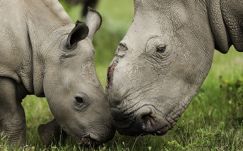Hi-tech boost for fight against rhino poaching
17 December 2014
Drone aircraft have helped reduce poaching incidents in the Hluhluwe-Imfolozi Park in
KwaZulu-Natal by 92 percent, says Shaya E-security, builders of the drones.
The drone aircraft stream live video via satellite to "armchair pilots" on the ground.
The custom-made drones clocked over 3 600 flying hours across in four separate
deployments across Hluhluwe-Imfolozi, which has one of the biggest rhino populations
in the world.
While as many as 50 rhino are killed in South Africa's worst affected areas, not a single
rhino was lost inside Hluhluwe-Imfolozi during the initial one month-long drone pilot
project, Shaya says.
"We've proved the value of drone technology in the fight against rhino poaching," said
Ben van Dyk, chief operations officer of Johannesburg-based Shaya E-security, which
built the drones.
"The world urgently needs a solution to the poaching crisis, and we believe we've found
it," Van Dyk
said.
Real time monitoring
Shaya's drone project features a range of remote-controlled drone designs, from a five-
metre wingspan craft to the much smaller battery-operated drone.
Van Dyk said the key to the drones' success was on-board sensors and high definition
cameras that are capable of providing real-time monitoring across a vast wilderness
area.
The craft flew at an altitude of around 500 metres and reached speeds of up to 180km
an hour, providing constant live video as well as thermal and infra-red surveillance.
The live images could be controlled or viewed remotely on portable devices such as
laptops, or even a mobile phone, enabling faster reaction time and better
communication with ground teams, the company said.
"Anti-Rhino Drone Operations form part of an overall strategy that includes an effective
Reaction Unit, intelligence gathering, and co-operation with the local SAPS," Van Dyk
said. The park's
management had effectively co-ordinated all the elements in the fight
against rhino poaching.
The project, which was concluded earlier this year, could provide a model for future
deployments across the country, said Shaya chief executive Ian Melamed.
"The problem with fighting rhino poaching in particular is that there is so much
intimidation and danger to the people on the ground fighting the poachers," Melamed
said. "As a result aerial security surveillance is a hugely viable alternative."
"Drones are no longer seen as 'killer machines' but have found a new purpose –
protecting animal life," Van Dyk said.
SAinfo reporter
 Thandi, who survived an attack by poachers in March 2012, nuzzles a calf born on Kariega game reserve in the Eastern Cape (Image: Kariega Game Reserve)
Thandi, who survived an attack by poachers in March 2012, nuzzles a calf born on Kariega game reserve in the Eastern Cape (Image: Kariega Game Reserve)




